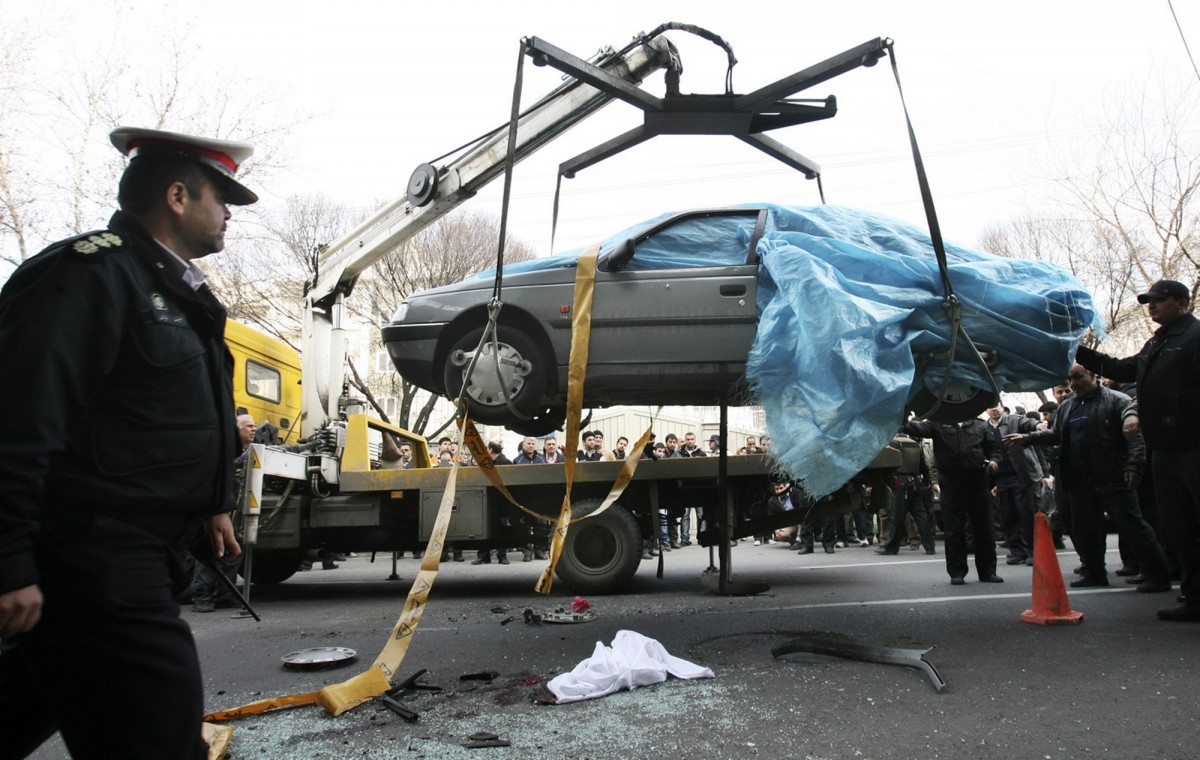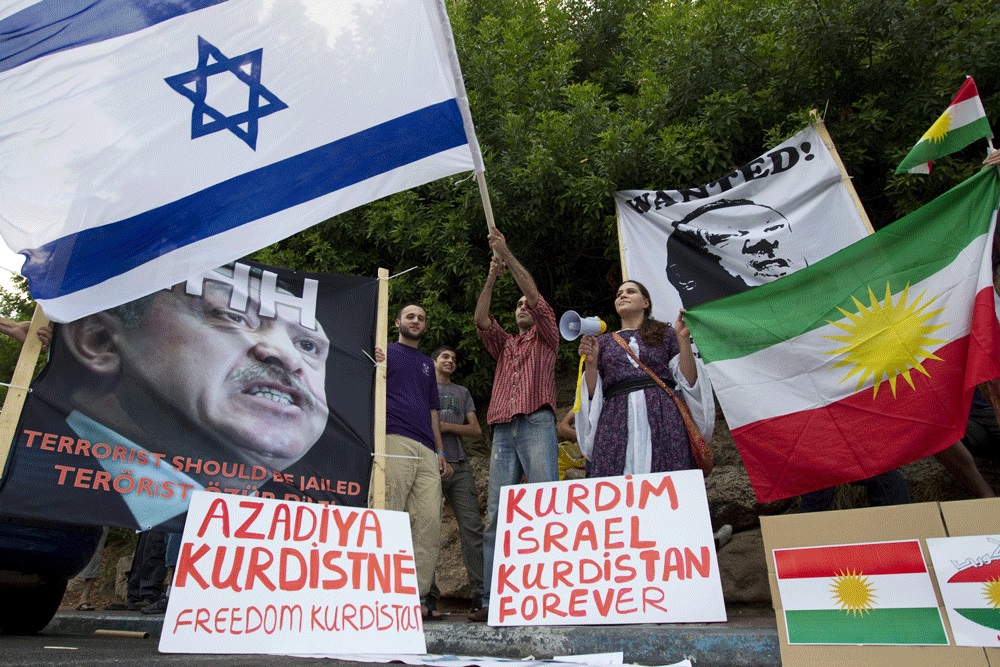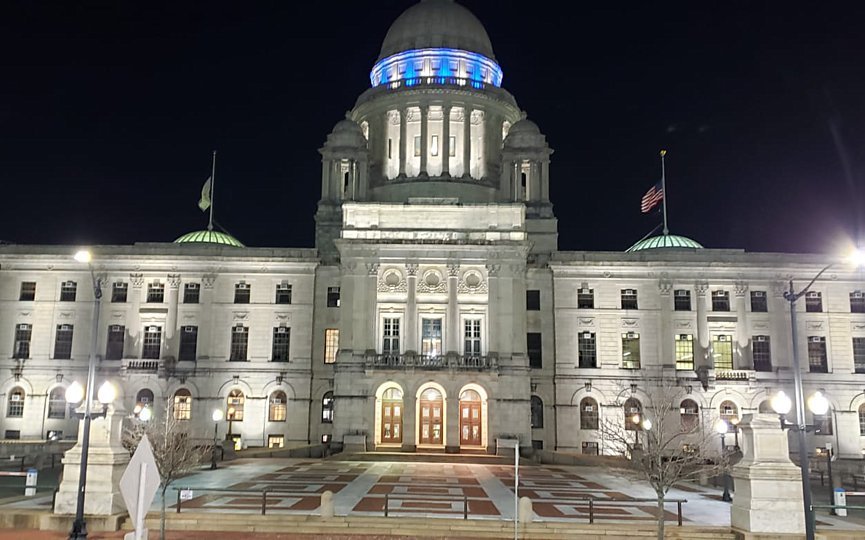
People gather around a car as it is removed by a mobile crane in Tehran, Iran, Jan. 11, 2012. Two assailants on a motorcycle attached magnetic bombs to the car of an Iranian university professor working at a key nuclear facility, killing him and wounding two people. The assassination was later confirmed to be a joint effort by the MEK and Israeli intelligence by U.S. officials. (AP/Meghdad Madadi)
NEW YORK (Analysis)– With blood still fresh on the streets of Tehran after last week’s deadly terror attack, the U.S. was quick to condemn the attackers. But in a sadly predictable move, President Donald Trump’s White House also blamed the victim, condemning Iran as a sponsor of terrorism.
While this may seem like merely the latest instance of insensitivity on Trump’s part, it is, in fact, emblematic of the strategy of supporting terrorism against Iran that Washington has employed for decades.
The official White House statement, while expressing grief over the attacks, was noteworthy for implying that Iran itself was responsible for the tragedy. “We underscore that states that sponsor terrorism risk falling victim to the evil they promote,” reads the second sentence of the statement.
Aside from the sheer tastelessness and callous disregard for the victims of the attack, the irony of the official statement was obviously lost on Trump. Perhaps if he wasn’t so sycophantic to Saudi oil executives, he might realize that it is the U.S., not Iran, that has a long history of sponsoring the same terrorism to which it later falls victim.
Moreover, if Trump had a stronger understanding of history, he would know that Iran has – for decades – been the victim of a terror campaign backed both directly and indirectly by the United States in the hopes of bringing regime change to the Islamic Republic, returning the country to its place as energy footstool of the West.
The recent history of terrorism against Iran
The subject of terrorism directed against the Islamic Republic of Iran would likely need a dissertation-length analysis well beyond the scope of this article. However, even a cursory examination of the use of terror against Iran reveals a number of worrying trends, with all roads leading West.
Put another way, terrorism against Iran is as American as apple pie; as British as shepherd’s pie; as Israeli as stolen Palestinian pie.
For instance, take the oft-touted “freedom fighters” of the Mujahideen-e-Khalq (MEK; also known as MKO), a terrorist group hailed as heroes by the U.S. neoconservative establishment, despite having been officially recognized by the U.S. government as a terrorist organization from 1997 through 2012. Indeed, so warm and cozy were these terrorists with policymakers, including key government officials, that through an intensive lobbying campaign, including advocacy from former Secretary of State Hillary Clinton, the MEK was officially removed from the State Department’s list of foreign terrorist organizations.

Senator John McCain has meets with the head of the US-designated terrorist organization, Mujahedin-e Khalq Organization (MEK), Maryam Rajavi, in the Albanian capital, Tirana, April, 2017.
Nevermind the fact that MEK was implicated by the Obama Administration itself as having colluded with Israel in assassinating Iranian nuclear scientists, a blatant violation of international law. But of course, this was nothing for MEK, whose history is one of assassination and terror against Iran.
As Anthony Cordesman and Adam C. Seitz noted in their book “Iranian Weapons of Mass Destruction: The Birth of a Regional Nuclear Arms Race?”:
“Near the end of the 1980-1988 Iran-Iraq War, Baghdad armed the MEK with heavy military equipment [provided by the US] and deployed thousands of MEK fighters in suicidal, mass wave attacks against Iranian forces…In April 1992, the MEK conducted near-simultaneous attacks on Iranian embassies and installations in 13 countries…In April 1999, the MEK targeted key Iranian military officers and assassinated the deputy chief of the Iranian Armed Forces General Staff…The pace of anti-Iranian operations increased during “Operation Great Bahman” in February 2000, when the group launched a dozen attacks against Iran.”
It should also be remembered that the U.S. opened its military base in Iraq to MEK, which used Camp Ashraf (also known as Camp Liberty) as a safe haven and staging area until it was closed (and MEK members killed) by former Iraqi Prime Minister Nouri al-Maliki.
Related: ISIS Strikes Again, Attack On Iran’s Capital Kills 12, Dozens Wounded
Perhaps a hundred other examples of MEK terrorism against Iran, sponsored and backed by the U.S., could be provided. Suffice to say that the removal of MEK from the U.S. government’s official terror organization list was the result of a well-funded and well-orchestrated lobbying campaign with many key allies on Capitol Hill and the Beltway, including some of the most influential neoconservative figures, such as Max Boot, Daniel Pipes, David Horowitz and Rudy Giuliani.
Another way of looking at this relationship would be to say that the U.S. has been the principal sponsor of one of the most violent and prolific anti-Iranian terrorist groups. And they are certainly not alone.
Washington has long been a backer of, and potential handler for, the organized crime and terror organization known as Jundallah. This notorious terror organization, which has operated on both sides of the Iran-Pakistan border in the region of Sistan-Baluchestan, has been led for decades by the Rigi family, a well-known anti-government crime family, and has been linked a number of high-profile terror attacks in recent years, including a deadly October 2009 bombing that killed over 40 people, including 15 Iranian Revolutionary Guard members.

During a funeral ceremony, people mourn next to flag-draped coffins of victims of two bomb blasts in the city of Zahedan, Iran, July 17, 2010. Jundallah, which has carried out several other bombings in southeast Iran over the past few years, claimed responsibility for the blasts, which killed 27. (Fars/Ali Azimzadeh)
Counterterrorism experts have long been aware of Jundallah’s historic ties to both U.S. and Israeli intelligence. As Foreign Policy reported in 2012, Israeli Mossad and U.S. CIA operatives essentially competed with one another for control of the Jundallah network for years. The report noted that:
“The [U.S. government] memos also detail CIA field reports saying that Israel’s recruiting activities occurred under the nose of U.S. intelligence officers, most notably in London, the capital of one of Israel’s ostensible allies, where Mossad officers posing as CIA operatives met with Jundallah officials.”
Consider for a moment the reality of what the report illustrated: U.S. intelligence officials were livid that their Israeli counterparts would meet with Jundallah while posing as CIA agents. Not only does this signal a turf war between the two ostensible allies, it indicates a much deeper and more intimate relationship between Western intelligence agencies and the anti-Iranian terror group. Considering Jundallah became the battleground between the CIA and Mossad, it’s not a stretch to say that the organization is, to some degree, influenced or even directly controlled by the U.S.
Related: Covert attacks on Iran may lead to overt war
Like Jundallah, Jaish al-Adl is a terror group operating in Iran’s southeastern province of Sistan-Baluchestan, as well as Pakistan’s Balochistan Province. The group has carried out numerous attacks against Iranian government institutions, including one infamous incident in March 2014 in which five Iranian border guards were kidnapped, with one being executed later.
According to the Terrorism Research and Analysis Consortium:
“[Jaish al-Adl is] an extremist Salafi group that has since its foundation claimed responsibility for a series of operations against Iran’s domestic security forces and Revolutionary Guards operating in Sistan and Balochistan province, including the detonation of mines [link added] against Revolutionary Guards vehicles and convoys, kidnapping of Iranian border guards and attacks against military bases… Jaish al-Adl is also opposed to the Iranian Government’s active support of the Syrian President Bashar al-Assad, which they regard as an attack on Sunni Muslims…Jaish ul-Adl executes cross-border operations between the border of Iran and Pakistan and is based in the Baluchistan province in Pakistan.”
Jaish al-Adl is certainly not riding alone on the terror train, as their cousins Ansar al-Furqan – a fusion of the Balochi Harakat Ansar and Pashto Hizb al-Furqan, both of which have been operating along Iran’s eastern border with Pakistan – have entered the anti-Iran fray in recent years.
According to the Terrorism Research and Analysis Consortium:
“[Ansar al-Furqan] characterize themselves as Mujahideen aginst [sic] the Shia government in Iran and are linked to Katibat al Asad Al ‘Ilamiya; Al-Farooq activists; al Nursra Front (JN), Nosrat Deen Allah, Jaysh Muhammad, Jaysh al ‘Adal; and though it was denied for some time, appears to have at least personal relationships with Jundallah…The stated mission of Ansar al Furqan is ” to topple the Iranian regime…”
Here one sees the intersection of the war against Iran and the ongoing war in Syria. Sunni extremist organizations such as Jaish al-Adl and Ansar al-Furqan see their war against Iran as an extension of the war against Syrian President Bashar al-Assad, itself part of the broader jihad against Shia Islam.
Weaponizing Iraq’s Kurds against Iran?
Thanks to WikiLeaks, it is well-documented fact that Israel, as well as the U.S., have long attempted to use Kurdish groups such as PJAK (an Iraqi Kurdish terror group) to wage continued war against Iran for the purposes of destabilizing its government. At the same time, however, both Washington and Tel Aviv have been involved on the ground with the Kurdish Special Forces by attempting to use them against Iran.
As Pulitzer Prize-winning journalist Seymour Hersh noted in 2004:
“The Israelis have had long-standing ties to the Talibani and Barzani clans [in] Kurdistan and there are many Kurdish Jews that emigrated to Israel and there are still a lot of connection. But at some time before the end of the year [2004], and I’m not clear exactly when, certainly I would say a good six, eight months ago, Israel began to work with some trained Kurdish commandoes, ostensibly the idea was the Israelis — some of the Israeli elite commander units, counter-terror or terror units, depending on your point of view, began training — getting the Kurds up to speed.”

Ethnic Kurdish Israelis protest outside the Turkish embassy in Tel Aviv, Israel, July 8, 2010.
Iran’s leaders have been keenly aware of the presence of Israeli special forces and intelligence on the ground in Kurdistan, knowing that ultimately it is Tehran in the crosshairs. And indeed, that has been the recent history of relations between Israel and the Barzani/Talabani-led Iraqi Kurds. As pro-Israeli blogger Daniel Bart noted:
“During most of that time there were usually some 20 military specialists stationed in a secret location in southern Kurdistan. Rehavam Zeevi and Moshe Dayan were among Israeli generals who served in Kurdistan…The Israelis trained the large Kurdish army of Mustafa Barzani and even led Kurdish troops in battle…The “secret” cooperation between Kurdistan and Israel is mainly in two fields. The first is in intelligence cooperation and this is hardly remarkable as half the world including many Muslim states have such relationships with Israel. The second is influence in Washington.”
Here again one sees the rich diversity of tactics employed by the U.S. and Israel against Iran. And while no one should be surprised that Washington and Tel Aviv would use regional antipathy and rivalries to gain leverage over and ultimately destabilize Iran, the use of terrorist groups as a weapon might come as a surprise to the uninitiated. But indeed, terrorism has been perhaps the most potent weapon in this war.
A new chapter in an old story
For Iran, the last seventy years have demonstrated that so-called “Western democracies” are actually anti-democratic and function as state sponsors of terrorism – precisely the terms hurled at Iran on a near-daily basis in the corporate media. From the CIA and MI6’s “original sin” of deposing Iran’s democratically elected Prime Minister Mohammad Mosaddeq in a coup d’etat in 1953, to imposing the U.S. puppet Shah with his secret police, torture chambers and forced disappearance of dissidents, the U.S. and its allies have been waging a terror war against the people of Iran for decades.
And what exactly is the great sin of the Iranian people? For one, they had the misfortune of residing in a country that sits atop trillions of dollars in energy reserves, making it a prime target for empires throughout the last century. Additionally, with its large, well-educated population, Iran is a lucrative market for Western corporations, so long as the pesky democratically elected government can be removed as an obstacle. And Iran, strategically located along both the Persian Gulf and Caspian Sea, bordering the Middle East and South Asia, forms a critical node in the projection of power for all Western empires, including the U.S.
Related: Trump Team Promises To ‘Deal With Iran’ Before New Administration Comes To Power
For these reasons, the Islamic Republic is rightly seen by Tel Aviv and Riyadh as a regional rival, a growing power that challenges Israeli-Saudi hegemony in the region. So it should come as no surprise that Iran has been repeatedly victimized by Western-sponsored terrorism.
And so when Trump or any of the neocons who have held the reins of U.S. foreign policy for years blasts Iran as a sponsor of terror at precisely the moment the country is reeling from a national tragedy, it is rather revealing. Because, indeed, it is the U.S. and its closest allies that have the long and sordid track record of sponsoring terrorism, not Iran.
It is the U.S. and other Western powers that have allowed the ISIS (Daesh) to proliferate, backed al-Qaeda, and sponsored myriad terror groups in waging war against Iran. It is Washington, Tel Aviv and Riyadh that have cast Iran as the villain and painted terror groups as legitimate resistance against the “mullocracy.”
Here again, when it comes to terrorism and U.S. foreign policy, we see the pot calling the kettle black. However, given Iran’s unwillingness to be cowed by terror, no one should be surprised if the kettle finally boils over.
Source Article from http://www.mintpressnews.com/history-state-sponsored-terrorism-iran/228785/
Related posts:
Views: 0
 RSS Feed
RSS Feed

















 June 13th, 2017
June 13th, 2017  Awake Goy
Awake Goy 








![[WATCH] Chance The Rapper Live Streams Illinois State Police Traffic Stop](https://www.jewworldorder.org/wp-content/uploads/2017/10/11.jpg)
 Posted in
Posted in  Tags:
Tags: 
















